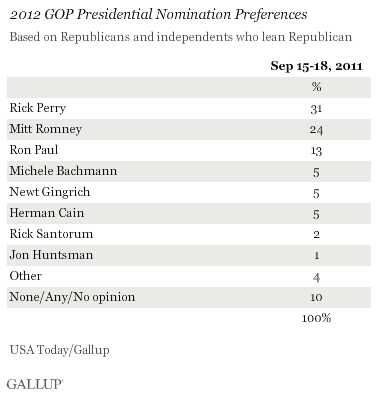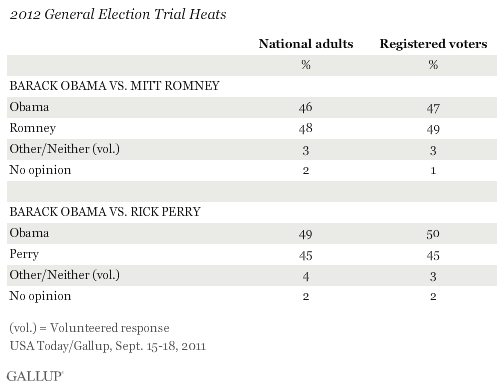PRINCETON, NJ -- Rick Perry leads Mitt Romney by 31% to 24% in a new USA Today/Gallup poll of Republican presidential nomination preferences. The two are well ahead of the rest of the GOP field, with Ron Paul the only other candidate in double figures.

These results are from a USA Today/Gallup poll conducted Sept. 15-18, and are based on a question that asks all Republicans and independents who lean Republican to choose from the eight leading announced Republican candidates for president. The results among Republicans and Republican leaners who are registered voters are similar, with Perry leading Romney, 31% to 23%.
Gallup Daily tracking of Republican preferences previously found Perry taking the lead from Romney shortly after his official entry into the race in August.
Perry also leads Romney in the new poll when Republicans and Republican leaners are asked which candidate they would prefer if the nomination narrows down to those two. On this basis Perry leads Romney by a slightly wider 10-point margin, 49% vs. 39%.

Both formats show Perry as the strong favorite among conservative Republicans, including self-described Tea Party supporters, while Romney does better among the smaller group of moderate/liberal Republicans and among Tea Party nonsupporters.
Republicans Want a Winner, and Romney Does Better Against Obama
Perry seems to have momentum, but that could be slowed in the coming weeks if Republicans start to perceive that Romney is more electable in the general election. The new poll finds the slight majority of Republicans, 53%, prefer to see their party nominate the person who has the best chance of beating Obama, even if that person does not agree with them on almost all of the issues they care about. Forty-three percent would prefer a candidate who does agree with them on almost all of the issues, even if that person does not have the best chance of winning in November 2012.
Romney currently edges out President Barack Obama by 49% to 47% in national registered-voter preferences for the November election, while Perry trails Obama by 45% to 50%. However, neither Romney nor Obama is ahead by a statistically significant margin.

Perry voters are slightly more likely than Romney voters to favor a candidate with the best chance of winning (59% vs. 52%). Thus, if Romney's edge in general election trial heats persists, some Perry voters might be swayed to back Romney instead.

Perry Still Lags in Recognition
It is unclear whether Perry fails to perform as well as Romney does against Obama because he is a less appealing candidate or because he is less well known. Gallup Daily tracking of Republicans' familiarity with the various Republican presidential candidates over the last 14 days finds that more Republicans still recognize Romney (85%) than Perry (76%). Still, the gap has narrowed considerably since July, when 86% recognized Romney and only 55% Perry. The current gap is likely to be even larger among independents and Democrats, who may be paying less attention to the Republican debates and news about the campaign in which Perry has received a great deal of national exposure.
Perry's deficit to Romney when each is matched against Obama is in fact exactly the same, four percentage points, nationally and among all three party groups. This suggests that a broad-based factor, such as recognition, is at work, as opposed to an ideological issue that would be more likely to produce reactions that are more partisan.

Bottom Line
Perry is holding on to his relatively newfound status as the front-runner for the Republican nomination in what could be shaping up as a two-man race between him and Romney. Playing the electability card might help Romney recover, particularly if he continues to outperform Perry in matchups against Obama in the coming months even as Perry becomes better known. However, his current advantage on this score over Perry may not be sufficiently convincing to cause an immediate shift in preferences among Republicans.
Survey Methods
Results for this USA Today/Gallup poll are based on telephone interviews conducted Sept. 15-18, 2011, with a random sample of 1,004 adults, aged 18 and older, living in all 50 U.S. states and the District of Columbia.
For results based on the total sample of national adults, one can say with 95% confidence that the maximum margin of sampling error is ±4 percentage points.
For results based on the sample of 889 registered voters, one can say with 95% confidence that the maximum margin of sampling error is ±4 percentage points.
For results based on the sample of 439 Republicans and Republican-leaning independents, one can say with 95% confidence that the maximum margin of sampling error is ±6 percentage points.
Interviews are conducted with respondents on landline telephones and cellular phones, with interviews conducted in Spanish for respondents who are primarily Spanish-speaking. Each sample includes a minimum quota of 400 cell phone respondents and 600 landline respondents per 1,000 national adults, with additional minimum quotas among landline respondents by region. Landline telephone numbers are chosen at random among listed telephone numbers. Cell phone numbers are selected using random-digit-dial methods. Landline respondents are chosen at random within each household on the basis of which member had the most recent birthday.
Samples are weighted by gender, age, race, Hispanic ethnicity, education, region, adults in the household, and phone status (cell phone only/landline only/both, cell phone mostly, and having an unlisted landline number). Demographic weighting targets are based on the March 2010 Current Population Survey figures for the aged 18 and older non-institutionalized population living in U.S. telephone households. All reported margins of sampling error include the computed design effects for weighting and sample design.
In addition to sampling error, question wording and practical difficulties in conducting surveys can introduce error or bias into the findings of public opinion polls.
View methodology, full question results, and trend data.
For more details on Gallup's polling methodology, visit www.gallup.com.
